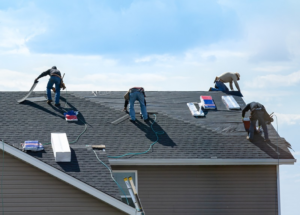Home » Posts tagged 'siding'
Tag Archives: siding
Tips and Insights on Window Replacement
If your windows are letting in too much sound, or if condensation has started building up between the double panes, it’s probably time to replace them. You can purchase replacement windows from a home center or through a window contractor.

Full-frame replacement windows install directly into the existing frames, while insert windows fit inside the frame. Both types are available in a wide range of shapes, sizes and styles. Call Window Replacement Ellicott City, MD for trusted advice.
The frame of a window is the structure that supports and anchors the glass. This is the part that is most often damaged and needs repair or replacement. The frame also serves as an important insulator and can contribute to energy efficiency. It can be made from wood, vinyl, fiberglass, or aluminum. Wood frames are most commonly used due to their warm look and insulating properties. Wood frames require more maintenance as they need to be sanded, sealed, and painted on a regular basis to protect the wood from moisture, UV rays, and temperature fluctuations that can cause damage.
A window replacement that is a full-frame installation will require the removal of the existing casing, trim, and jambs from both the inside and outside of the home. The old sash will then be removed and the new replacement window installed in the rough opening. The installer will then put the insulation in and caulk around the edges to help seal out drafts. A final coat of paint or stain will be applied to enhance the aesthetic and protect the window from rain, snow, and debris.
When a window is installed in a load-bearing wall, the framing may need to be reinforced or augmented to support the weight of the new window. This is also the time to address any water damage or rot that has developed in the existing frame.
While a minor case of rot may be repaired, extensive or deep rotting usually indicates that the frame needs to be replaced. A professional will be able to advise you as to whether the damage is repairable or if it would be better to invest in a full-frame replacement.
An alternative to wooden frames is a composite frame. This style combines the best of both worlds as it provides the warmth and insulating qualities of wood with the low maintenance and energy efficiency of fiberglass, vinyl, or aluminum. A common brand of these frames is called Alside and can be purchased at most hardware stores. They come in a variety of colors and finishes to compliment any home.
Glass
When a window becomes broken or cracked, replacing the pane can be a great way to increase home safety, as well as increase your home’s energy efficiency and curb appeal. However, before you choose to repair or replace your window glass, it’s important to consider the entire picture – including your budget and end goals.
Window glass costs make up about 40% to 60% of your total window replacement cost. It’s an expensive component, and it can add up quickly, especially if you opt for larger windows or multipaned designs that require more labor to install.
To start, prepare the work area by removing any curtains or furniture in the vicinity and covering the floor with a sheet of plastic or cloth for protection. Then, carefully remove any old glazing material and paint by using a pull-type scraper, a chisel, or a heat gun. If the pane is secured with pieces of wood molding, use a flat pry bar to remove them and then scrape the grooves to prepare the surface for your new glass.
Next, measure the opening and subtract 1/16 inch from each side to ensure a snug fit for your new glass pane. Visit your local hardware store to have a piece of tempered, laminated, or low-E glass cut to this size and test it in the frame for a secure fit. When it comes time to reinstall the window, run a line of silicone caulk around the edges and press the pane in place.
Although you may only need to replace the pane, this is a perfect opportunity to upgrade to a more energy-efficient style of window. Double-pane insulated glass windows are available that are much more efficient than older single-pane options. In addition to increasing energy efficiency, double-pane windows also reduce outside noise and provide more privacy while adding value to your home.
Sash
The sash is the window frame part that holds glass panes in place and creates a barrier between the inside and outside of your home. Its design and appearance vary based on architectural style, window type (such as single-hung and double-hung), and personal preference. Sash options include muntin bars, decorative grilles, and clad or raw wood. A sash is also the mechanism that allows you to open and close your window.
If you’re experiencing problems with opening and closing your windows, you may need to replace the sash. This is an easy DIY task, but it’s a good idea to consult a professional window contractor to make sure the job is done right.
The first step in replacing a sash is to take full measurements of the window opening and frame. This will ensure you purchase the correct replacement sash for your window.
You should also clean the frame, sash, and tracks. Dust buildup can prevent your sash from opening and closing smoothly, and it can lead to rust or corrosion of hardware. Using a vacuum cleaner attachment and a wood filler to repair any cracks or damage can help keep your sash in good condition for as long as possible.
Window sashes are available in several different materials, including aluminum and vinyl. Each material has its own advantages and disadvantages. Aluminum sashes are relatively inexpensive and are less likely to warp, crack or discolor over time. However, they are less energy efficient than wood sashes. Vinyl sashes are more expensive than aluminum, but they last longer and offer greater energy efficiency than wood.
If your sash is damaged, it’s important to fix the problem as soon as possible to prevent further damage and extend the life of your window. Replacing a window sash is a moderately complex project that requires removing the old hardware and parts, installing new ones, and caulking to seal any gaps. Getting the job done properly by a professional will help you avoid any structural problems that may arise from a botched installation.
If your sash’s pulleys are squeaking, they can usually be lubricated to stop the noise. A small amount of silicone spray can be used to lubricate the pulleys and make your windows easier to open and close.
Trim
A window’s trim enhances its beauty and helps the window stand out. It adds a decorative touch and coordinates with the molding in your home’s other rooms.
When you replace your windows, you should consider replacing the interior trim as well to ensure a uniform look. Window casings come in different widths and styles to suit your home’s design. You can also find a wide range of colors and stains to match your other trim and furniture. Some materials require more maintenance than others, so think about the style and longevity of your new trim before deciding on it.
Most trim is made from wood, although MDF and finger-joint pine are popular alternatives. Wood offers a classic, natural look and is durable and versatile. It can be painted to complement your home’s color scheme or stained to bring out the natural grain and texture of the wood. Some homeowners choose to forgo traditional trim altogether, opting for a more minimal and modern look with integrated sealing solutions built into the frame itself.
Before installing new trim, clean the old trim surface to remove any dirt and debris that may interfere with the application of caulk. Score the edges of the existing trim with a utility knife to prevent damaging the wall or window framing. Then, gently pry off the casing, stool, and apron molding using a flat pry bar. Remove any nails or screws left behind.
Once the surface is clean, prepare it for caulking by masking over any areas that will not be painted to protect them from accidental smears. A ladder may be necessary if you’re working on higher windows. Then, measure the lengths of your trim pieces to avoid wasting any wood. Plan out your pieces and make a master cut list in advance to save time on the job. Remember to buy a few extra pieces for bad splits or mistaken cuts.
Before you start caulking, it’s important to prep the area with a damp cloth or sponge. This will clean any dust and dirt from the surface, ensuring the caulk adheres properly and provides a watertight seal. After letting the caulk dry, you can paint or stain the trim to match your home’s design and décor.
